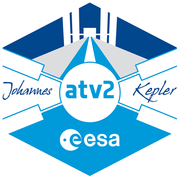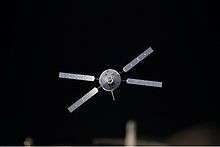Johannes Kepler ATV
 Johannes Kepler in orbit, prior to its rendezvous with the ISS | |
| Mission type | ISS resupply |
|---|---|
| Operator | European Space Agency |
| COSPAR ID | 2011-007A |
| SATCAT № | 37368 |
| Spacecraft properties | |
| Spacecraft type | ATV |
| Manufacturer |
EADS Astrium Thales Alenia Space |
| Launch mass | 20,050 kilograms (44,200 lb) |
| Start of mission | |
| Launch date | 16 February 2011, 21:51 UTC |
| Rocket | Ariane 5ES |
| Launch site | Kourou ELA-3 |
| Contractor | Arianespace |
| End of mission | |
| Disposal | Deorbited |
| Decay date | 21 June 2011, 20:44 UTC |
| Orbital parameters | |
| Reference system | Geocentric |
| Regime | Low Earth |
| Inclination | 51.6 degrees |
| Docking with ISS | |
| Docking port | Zvezda Aft |
| Docking date | 24 February 2011, 15:59:19 UTC[1] |
| Undocking date | 20 June 2011, 15:46 UTC[2] |
 | |
The Johannes Kepler ATV, or Automated Transfer Vehicle 002 (ATV-002), was an unmanned cargo spacecraft built to resupply the International Space Station (ISS). It was launched on 16 February 2011 by the European Space Agency (ESA).[3] Johannes Kepler carried propellant, air and dry cargo weighing over 7,000 kilograms (15,000 lb),[4] and had a total mass of over 20,000 kilograms (44,000 lb),[5] making it, at the time, the heaviest payload launched by the ESA.[6] The spacecraft was named after the 17th-century German astronomer Johannes Kepler.[7]
Johannes Kepler was the second ATV cargo resupply vehicle to be launched, following the Jules Verne mission of 2008. Johannes Kepler carried around five tons more cargo than Russia's Progress-M resupply spacecraft, and about 1.5 tons more than the Japanese HTV.[8] The ATV used 4,500 kilograms (9,900 lb) of fuel to boost the ISS's altitude from 350 to 400 km.[9]
Many of the supplies aboard the ATV were used for the Space Shuttle mission STS-133 and the ISS Expedition 26.[1] A Reentry Breakup Recorder was placed aboard the ATV before it undocked from the ISS on 20 June 2011.[10] Johannes Kepler performed a destructive re-entry as intended on 21 June 2011, with its remains impacting the Pacific Ocean.
Spacecraft
Johannes Kepler consisted of two sections: the Propulsion Module, with four main engines and 28 smaller maneuvering thrusters, and the Integrated Cargo Carrier, which attached directly to the ISS and could hold up to eight standard payload racks.[8] The four solar wings of the spacecraft provided up to 4,800 watts of electrical power to its rechargeable batteries.
The ATV's rendezvous and docking system mounted a telegoniometer, which functioned as a radar system, and two videometers, which fired laser pulses at cube-shaped reflectors on the ISS' Zvezda service module for range detection. The nose of the spacecraft contained rendezvous sensors and Russian docking equipment.
Specifications
| Diameter at widest point | 4.5 metres (15 ft) |
| Length (probe retracted) | 9.7 metres (32 ft) |
| Spacecraft mass (with fluids loaded) | 20,020 kilograms (44,140 lb) |
| Deployed solar array width | 22.3 metres (73 ft) |
Mission payload
| Cargo | Mass |
|---|---|
| ISS reboost/attitude control propellants |
4,534 kilograms (9,996 lb) |
| ISS refuel propellant |
850 kilograms (1,870 lb) |
| Oxygen gas | 100 kilograms (220 lb) |
| Water | 0 kilograms (0 lb) |
| Dry cargo (food, clothes, equipment) |
1,600 kilograms (3,500 lb) |
| Total | 7,084 kilograms (15,618 lb) |
- Source: NASA[11]
GeoFlow II
Johannes Kepler delivered the GeoFlowk II hydrodynamics experiment container to the ISS. This experiment was designed to observe liquid movements in microgravity, and compare them with computer simulations, thus helping scientists to understand convection currents within the Earth’s mantle.[12]
Mission summary
Launch

On 16 February 2011 UTC, Johannes Kepler was launched on an Ariane 5ES rocket from the Guiana Space Centre in Kourou, French Guiana. The launch was conducted by Arianespace on behalf of the ESA.[3]
The first launch attempt, on 15 February 2011, was halted four minutes before lift-off, due to an erroneous signal from one of the rocket's fuel tanks.[13]
Docking


Docking with the ISS was completed on 24 February 2011 at 15:59 UTC, after a 15-minute delay.[14] The spacecraft traveled over eight days to catch up with the space station, and arrived at the aft port of the station's Zvezda service module. During the rendezvous operations, ATV-2 traveled a total of 2.5 million miles. The docking occurred as ATV-2 and the ISS flew over the coast of Liberia in western Africa. Hooks and latches engaged a few minutes later to firmly attach ATV-2 to the ISS.
The Johannes Kepler mission marked the first time European astronauts were on board the International Space Station during an ATV mission, with Italian astronaut Paolo Nespoli welcoming the ATV's arrival. ESA astronaut Roberto Vittori was also aboard the ISS at the same time as the ATV, having arrived on Space Shuttle Endeavour on the STS-134 mission in May 2011.[15]
ISS altitude Increase
.jpg)
Johannes Kepler was used to boost the ISS's standard altitude from about 350 kilometers (220 statute miles) to 400 km (248 miles).[9] The higher altitude has lower atmospheric drag, which reduces the propellant needed annually to maintain the station's altitude from 6,800 kg (15,000 lb) to roughly 3,630 kg (8,000 lb), depending on atmospheric conditions.[9] The ATV used about 4,500 kg (9,900 lb) of rocket fuel to accomplish this change, with the reboost occurring incrementally over several months.[9]
End of mission and deorbit
On 20 June 2011, Johannes Kepler undocked from the ISS.[16] At 18:30 UTC (20:30 CEST) that same day, while preparing to deorbit, the ATV was forced to conduct a debris-avoidance maneuver, using some of its remaining fuel to move into a safe orbit after NASA warned of a potential collision with orbital debris.[17] On 21 June 2011, the ATV deorbited, burning up in the atmosphere as planned over the South Pacific Ocean at around 22:44 CET.[18]
ATV missions
| Designation | Name | Launch date | ISS docking date | Deorbit date | Sources |
|---|---|---|---|---|---|
| ATV-1 | Jules Verne | 9 March 2008 | 3 April 2008 | 29 September 2008 | [19][20] |
| ATV-2 | Johannes Kepler | 16 February 2011 | 24 February 2011 | 21 June 2011 | [21][22] |
| ATV-3 | Edoardo Amaldi | 23 March 2012 | 28 March 2012 | 4 October 2012 | [23][24][25][26] |
| ATV-4 | Albert Einstein | 5 June 2013 | 15 June 2013 | 2 November 2013 | [27][28][29][30] |
| ATV-5 | Georges Lemaître | 29 July 2014 | 12 August 2014 | 15 February 2015 | [31][32] |
See also
References
- 1 2 NASA Live TV broadcast. 24 February 2011. Retrieved 12 January 2013.
- ↑ ESA ATV blog. Retrieved 11 June 2011.
- 1 2 "Europe’s ATV Johannes Kepler supply ship on its way to Space Station". ESA Portal. 16 February 2011. Retrieved 6 December 2011.
- ↑ NASA's Consolidated Launch Schedule. Retrieved 22 March 2012.
- ↑ Chris Gebhardt (15 February 2011). "Ariane 5 launches ATV-2 for journey to the ISS". NASASpaceflight.com. Retrieved 20 March 2011.
- ↑ "Europe's ATV space ferry ready for launch". ESA. 3 February 2011. Retrieved 3 February 2011.
- ↑ "Second ATV named after Johannes Kepler". ESA. 19 February 2009. Retrieved 16 July 2010.
- 1 2 ESA (January 2011). "INFORMATION KIT ATV Johannes Kepler" (PDF). ESA. Retrieved 26 June 2011.
- 1 2 3 4 "Higher Altitude Improves Station's Fuel Economy". NASA. 14 February 2011. Retrieved 4 November 2013.
- ↑ "Unique Aerospace Invention Ready For Debut". Space Travel.com. 29 March 2011. Retrieved 29 March 2011.
- ↑ NASA.gov: JK ATV Mission Cargo
- ↑ "Project Geoflow II flies into space aboard Ariane 5". ASTRIUM. Retrieved 3 August 2011.
- ↑ Atkinson, Nancy. "ATV 'Johannes Kepler' Launch to Space Station Delayed to Wednesday". Universe Today. Retrieved 4 November 2013.
- ↑ Stephen Clark (24 February 2011). "Europe's automated cargo ship docks with space station". Spaceflight Now. Retrieved 20 March 2011.
- ↑ "NASA Assigns Crew for STS-134 Shuttle Mission, Change to STS-132". NASA. 11 August 2009. Retrieved 31 March 2012.
- ↑ Moskowitz, Clara (20 June 2011). "Huge Robot Cargo Ship Departs Space Station". Retrieved 20 June 2011.
- ↑ ESA ATV blog. Retrieved 21 June 2011.
- ↑ ESA ATV blog. Retrieved 21 June 2011.
- ↑ "Multi-Program Integrated Milestones" (PDF). NASA. 25 January 2008. Retrieved 20 May 2013.
- ↑ "European Cargo Ship Begins Maiden Space Voyage". Space.com. 9 March 2008. Retrieved 20 May 2013.
- ↑ "Europe's second cargo freighter to fly in December". Spaceflight Now. 17 September 2010. Retrieved 18 September 2010.
- ↑ "One-day delay of final shuttle launch makes room for ATV". Spaceflight Now. 1 October 2010. Retrieved 2 October 2010.
- ↑ "Third ATV named after Edoardo Amaldi". ESA. 17 March 2010. Retrieved 17 March 2010.
- ↑ "Europe's third cargo vehicle docks with the Space Station". ESA – ATV. 29 March 2012. Retrieved 31 March 2012.
- ↑ "Deorbit burns set for Tuesday night/Wednesday morning". ESA ATV blog. Retrieved 2 October 2012.
- ↑ "Mission accomplished for ATV Edoardo Amaldi". Space-Travel.com. 4 October 2012. Retrieved 8 October 2012.
- ↑ "ATV-4 scheduled for summer liftoff". ESA. 11 April 2013. Retrieved 14 April 2013.
- ↑ "Mission brochure – ATV Albert Einstein". ESA. 14 April 2013. Retrieved 12 June 2013.
- ↑ "Europe's largest spaceship reaches its orbital port". ESA. 15 June 2013. Retrieved 15 June 2013.
- ↑ "A fiery end to a perfect mission: ATV Albert Einstein". ESA. 2 November 2013. Retrieved 3 November 2013.
- ↑ http://blogs.esa.int/atv/2014/07/22/arianespace-flight-va219-ariane-5-es-atv-5-launch-scheduled-for-tuesday-july-29/
- ↑ http://www.esa.int/Our_Activities/Human_Spaceflight/ATV/Last_ATV_reentry_leaves_legacy_for_future_space_exploration
External links
| Wikimedia Commons has media related to Johannes Kepler (spacecraft). |
- ESA – ATV
- ESA – ATV blog
- Mission Overview Video
- Launch Kit Flight 200 Ariane 5ES ATV Johannes Kepler
